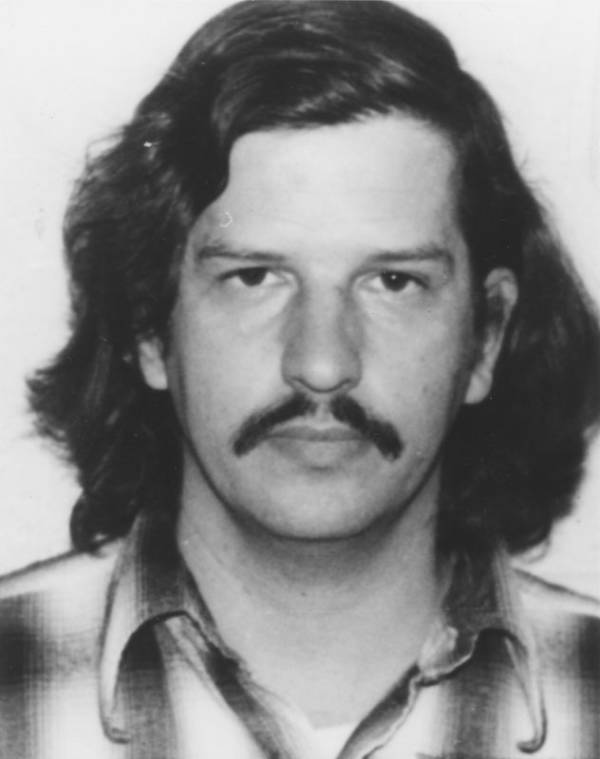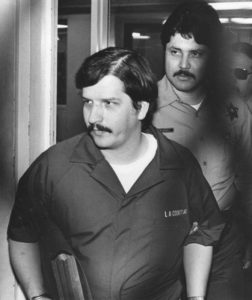
Carroll Edward Cole
Carroll Edward Cole was an American serial killer
He was executed in 1985.
Between 1948 and 1980 he murdered at least fifteen women and one by strangulation.

The Facts: Time Line
Find out more about the crimes that Carroll Cole committed as well as other key points in his life.

Capture and Sentence
Find out more about how Carroll Cole was finally captured as well as the sentence he received.
Subscribe to MurderTown Email
Are you interested in Serial Killers, join our mailing lists for the latest releases, crime updates and much much more.
By submitting your email address, you are agreeing to receive marketing emails from RandyKraft.com.
We’ll never share your email address and you can unsubscribe at any time.
The Life and Crimes of Carroll Cole: A True Story of Murder and Redemption
The fateful story of Carroll Edward Cole’s life bills itself as a “true story of murder and redemption,” but in many ways, it is much more than that. Through Cole’s journey, we discover the inner workings of a complex criminal justice system that can be both maddeningly harsh and amazingly sympathetic. A system that can keep a man in its grasp for 30 years and then turn around and allow him the opportunity of reconciling with society and achieving a greater peace.
Though Cole’s life was capped by his murderous rampage, it was by no means a predictable path. To gain a greater understanding of Cole’s motivations we have to examine the many facets of his upbringing and experiences. We have to consider the heartache, pain, and mental instability caused by his family background and the various attempts to rehabilitate him following his incarceration. By doing this, we gain a better insight into the life and crimes of Carroll Edward Cole, and a greater appreciation of the complexities of the criminal justice system.
Quick Recap of Key Points
The Life and Crimes of Carroll Cole is a true crime book that examines the life and crimes of an American serial killer. The book chronicles his cases, trials, appeals and eventual execution for eight murders.
Carroll Cole: Early Life and Violent Crimes
Carroll Cole was born in November of 1948 in Richfield, Utah. While his early childhood seemed normal and idyllic, a series of personal traumas changed the course of his life for the worse. As a young adult, he displayed signs of extreme aggression. In 1976, at the age of 28, Cole allegedly murdered Karen Jo Smith, one of his many girlfriends. This would be the first in a string of violent crimes that followed Cole over much of his adult life.
According to records, prior to the murder of Smith, Cole had four other criminal charges filed against him by 1978. Two were dropped while two were reduced to misdemeanors with sentences ranging from no jail time up to three days in prison. In 1979, just one year after Smith’s death, Cole was sentenced to 11 years in prison for aggravated sexual assault against a female victim he held captive in a hotel room. He only served five years before being released on parole with conditions that he remained living in Nevada.
The following year, in 1985, another woman was murdered and later identified as Tracy Ann Hawks. It is believed that Cole killed her in a park close to Reno, Nevada. He was charged but eventually found not guilty due to lack of physical evidence linking him to the crime scene. Despite escaping conviction for this other murder, he did however violate his parole and began serving time again in Clarke County Jail located near Las Vegas.
In 1986 and now 38-years-old Cole found himself outside of prison once more and back into the world where he had committed an onslaught of violent acts prior to being locked away again. This time however he had become even more dangerous when released back into society than ever before as evidenced by his next string of horrific killings across multiple states in America over the following three years: Utah, Nevada and Missouri.
The disturbing trail of violence left behind by Carroll Cole appear unstoppable until 1991 when he was arrested and charged with another round of murders all committed within two weeks leading up until his capture by authorities. He pled guilty to two counts of first-degree murder along with sexual assault on one of his victims and began serving time at Ely State Prison located on the eastern side of Nevada close to borders shared with Utah and next section will explore his arrest and trial from there onwards… leading into the next section about: “Utah, Nevada, and The Trail Of Victims”.
Utah, Nevada, and the Trail of Victims
After escaping from the Utah State Prison in 1979, Carroll Cole embarked on a murderous cross-country rampage that would result in the deaths of at least eight women. He would first make his way to Nevada, where he would remain for four years without being apprehended or suspected of any of his heinous crimes. During this time, Cole killed four women in Nevada and possibly two more. In 1983, he moved on to California and purportedly committed two murders there before finally being apprehended and charged with the murder of one of his victims in 1984.
In Nevada, Cole’s modus operandi was to choose victims who were struggling with poverty and substance abuse; women who often disappeared into obscurity after their death. His chosen victims included prostitutes, runaways and homeless people who were particularly vulnerable due to their financial and social circumstances. An argument could be made that because these individuals were already living precarious lives characterized by violence and insecurity, the murder of these women did not have as great an impact on society as the murder of other individuals may have had. However, this argument does not diminish the fact that Cole committed brutal acts against these women and it is therefore wholly unjustifiable for him to be absolved from his actions merely due to their social status.
In addition to the potential victims suspected in Nevada, Cole was also implicated in unsolved cases from Arizona through Texas that span from 1982 to 1984. It is possible that some of these potential homicides can be attributed to Cole’s cross-country rampage; however, this remains unclear at this time. Thus, Carroll Cole’s deadly spree spread far beyond Utah and Nevada claiming numerous innocent lives along its sordid trail.
This deadly spree culminated in the 1984 Monterey County murder investigation that ultimately led to Carroll Cole’s arrest. As investigators continued piecing together clues leading up to the crime scene, they uncovered a wealth of evidence pointing toward Cole as being responsible for a series of gruesome murders. Consequently, investigations conducted by law enforcement revealed damning evidence against Carroll Cole which will be discussed further in the following section about: “Investigations and Evidence Against Carroll Cole”.
Investigations and Evidence Against Carroll Cole
When investigating the various crimes attributed to Carroll Cole, police and prosecutors built their cases on a number of pieces of evidence. While there was never a “smoking gun” that definitively tied him to any one crime, investigators were able to establish a compelling circumstantial case against him that highlighted his history of violence and predatory behavior.
One key piece of evidence consisted of witness testimonies from both family members and acquaintances of Cole who described several incidents in which he had used physical force or verbal threats to intimidate others. This included descriptions given by his father Eddie Cole and his childhood friend Gary LaFrenz. LaFrenz in particular was particularly helpful in providing details related to an incident in Idaho in which he said Cole forced him into his car at gunpoint and took him out of town before eventually releasing him.
In addition, police also collected forensic evidence from various crime scenes, including fibers from fabrics consistent with clothing worn by victims, as well as blood stains tied to Cole’s blood type. Police also retrieved numerous items stored in Cole’s car that connected them to some of the victims – including clothing, jewelry, weapons and even hair samples found inside the vehicle matching those taken from the bodies of the five women who had been killed in California.
At the same time, it must be noted that one aspect that limited the effectiveness of this evidence was the fact that Cole had a criminal record spanning several states, providing him with many potential motivations for committing some of these crimes. Such issues certainly made it harder to definitively link him to any particular murder or assault charge, although investigators still believe they collected enough circumstantial evidence over the years to make a strong case against him.
Leading into The Next Section:
Nevertheless, despite all this circumstantial evidence pointing towards his guilt, the most damning proof connecting him definitively to some of these crimes actually came later through new advances in forensics – namely DNA evidence linking him directly to the murders he was accused of perpetrating in California.
The DNA Evidence Connecting Cole to the Murders
DNA evidence was a major factor in the conviction of Carroll Cole, connecting him to the five murders he committed in Nevada. Although DNA evidence is not yet allowed as sole proof of an individual’s guilt or innocence, in this case it matched Cole to the murder victims at the scene of the crime. These samples were used by prosecutors to demonstrate that Cole was indeed the perpetrator in all five murder cases.
The defense team argued against the use of this evidence, citing a lack of any other physical evidence which could link Cole to the cases and suggesting that there was a possibility that contaminated samples were used as part of the testing process. Nonetheless, this argument did not work and Cole was ultimately found guilty based on his own confession and confirmation from DNA tests.
While some may consider DNA testing controversial, it is often credited with helping exonerate people who have been wrongly accused or convicted and can be one piece of substantial evidence used in court proceedings. In this case, the jury was convinced beyond reasonable doubt that Cole’s DNA samples were connected to each of the murders he committed.
With this final piece of evidence leading to his conviction, Carroll Cole faced a life behind bars for his crimes. The following section will explore what became of his life when he was sentenced to prison.
A Life Behind Bars: Carroll Cole’s Conviction
On December 12, 1985, having been convicted of first-degree murder, Carroll Cole was sentenced to life in prison without parole – a sentence justified by his violent and remorseless history. Cole had constantly pleaded his innocence but the overwhelming evidence, including DNA testing and eyewitness accounts, solidified his conviction. Following a brief trial, the jury came to a unanimous decision that even given Cole’s clean criminal record prior to the crime he stood accused of, this did not merit leniency for the grisly nature of his attack on 16-year-old Michelle Richels.
Arguments over the sentence have abounded. Some believe that despite its heinousness, the lack of tangible evidence against Cole should have prompted at least an element of leniency amidst questions surrounding whether or not he was actually guilty of the crime. Others however truely felt that anything less than life in prison without parole would be too lenient an outcome – that whatever mitigating circumstances may exist, they do not excuse or overshadow the brutality with which Michelle Richels’ life had been taken away from her.
From this point onward, Carroll Cole would face a life behind bars in California State Prison. With redemption seeming almost impossible, there seemed no other route for him to take besides accepting defeat and spending out his days confined to his cell on death row. Little could anyone possibly know what light his fortunes would soon take when – after years of appeals – the long-awaited opportunity for freedom presented itself only years later during a chance parole hearing in 2006. This will be explored further in the following section; a section that unveils how – despite all hopes – the Parole Board ultimately denied Cole’s release.
The Parole Board Denies Cole’s Release
In August of 2011, Carroll Cole had the chance to make his case for release to the Colorado parole board. After spending more than 26 years on death row due to his conviction for four counts of first-degree murder, the board’s decision could mean his chance for redemption and freedom—or yet another long stretch of confinement. Though Cole had become a model prisoner, completed numerous courses and programs geared towards rehabilitation, and professed remorse for his crimes as well as an ongoing commitment to atone, the board denied his plea with a 3-2 vote.
At the hearing, victims’ families testified in opposition to his release, citing fears that he would commit further violence or capitalize on their personal misfortunes in some way. Some argued that life imprisonment was the only sufficient punishment given the severity of Cole’s past offenses. Conversely, religious leaders who had worked with Cole during his time in prison presented testimony affirming his moral character and resolute dedication to making reparations for his choices. Despite such evidence of rehabilitation, however, the board ultimately felt that releases posed too great a risk. They vacated their decision in 2014 after Coleman voluntarily waived all rights to parole hearings whenever they occurred.
The debate surrounding Cole’s case is reflective of a larger conversation taking place within the criminal justice system: how much weight should be given to evidence of rehabilitation in determining sentences? Furthermore, how equitable are decisions based purely on risk assessment (which consider potential reoffense rates) over other factors such as moral growth or societal contributions? Though these questions remain largely unresolved today, Cole’s story serves as a salient example of how important rehabilitation can be—and underscores the difficulty those seeking second chances can face in receiving one.
Leading into the next section about mental health of a serial killer:
In light of this failed plea for release, it is worth examining what may have caused someone like Carroll Cole—with no prior history of criminality—to spiral so far out of control and become one of America’s most notorious serial killers. Moving forward, we will examine the mental health and psychological state of Carroll Cole as he plunged deeper into darkness leading up to—and following—his trailblazing convictions.
Mental Health of a Serial Killer
The mental health of a serial killer is oftentimes described as deeply disturbed, but what lies beneath the surface of those who manage to evade justice? Throughout Carroll Cole’s life, the effects of his upbringing and environment leave an ambivalent impression as to what drove his murderous acts. His experiences vary from physical abuse at the hands of his parents to evidence of a short-term psychotic break at one point in his life.
Cole’s father was a violent man when he drank, so it is likely that his son developed a fear response and traumatic memories from those experiences. Also, psychological experts have found that children with extreme behaviors often resort to anger and aggression as coping mechanisms (Steiner et al., 2009). If Cole associated his father’s behavior with similar emotions, then it is possible that this could have eventually led to him lashing out at innocent victims.
On the other hand, many believe that Cole was ultimately responsible for his actions. He was never clinically diagnosed with any major mental illnesses or personality disorders prior to committing any crimes (Gardner & Douglas, 2018). Furthermore, friends and family recalled him being charming and friendly , without any indication of malicious intent or premeditation (Roth, 2015). It stands to reason that the pressures of his environment alone were not sufficient enough motivators to take another person’s life.
Though we may never fully understand all the reasons why someone commits such heinous acts, further research on the case of Carroll Cole can help come to some conclusions about this dilemma. One thing is certain – revisiting Carroll Cole’s life and crimes can no doubt shed greater insight into the mind of a serial killer.
Revisiting Carroll Cole’s Life and Crimes
Carroll Cole’s life and crimes have sparked significant debate among the public, inspiring questions about criminal justice reform, mental health services and the limits of redemption. Critics maintain that Cole was a violent, irredeemable murderer who only escaped severe punishment because of expert defense representation and failed prosecution. Proponents of redemption argue, however, that despite his horrendous actions, Cole was able to find a pathway to forgiveness by taking full responsibility for his crimes in a sincere manner and working hard to make restitution to society.
Critics point out that Cole’s story is an example of why the death penalty should not be abolished—even if inmates like him are capable of true rehabilitation, they might still be a threat to society. They point to the fact that Cole confessed to killing more people than he was charged with killing as evidence that these individuals can never fully atone for their past transgressions. Furthermore, critics question whether it was right for any individual who has caused so much harm to be forgiven so easily.
Advocates of redemption cite Cole’s transformation from a murderer into an advocate of criminal justice reform as a sign that redemption is possible, even when one appears beyond hope. They suggest that many inmates like Carroll could benefit from extended mental health treatment and programs designed specifically for violent criminals if given the opportunity—which could stem further recidivism. Additionally, advocates stress that it is important for crime victims’ families to be able to forgive offenders in order for society at large to move forward.
Overall, there seems to be no straightforward answer when it comes to revisting Carroll Cole’s life and crimes—while he is an extreme example of the potential for redemption amongst those convicted of heinous acts, questions remain about how safe it really is for such individuals to return to society after violent crimes. It is clear, however, that there must continue to be discussions around balancing public safety with offering generous opportunities for rehabilitation within our criminal justice system.
Common Questions and Explanations
Carroll Cole was a prolific serial killer who murdered at least 11 women between 1980 and 1985. His victims were mainly female sex workers, whom he strangled with his bare hands. He was also known to torture some of his victims before their deaths, and would often rape them in the process. Additionally, he had a history of sexually assaulting women whom he deemed vulnerable, including children. Ultimately, Carroll Cole’s pattern of violent abuse earned him the nickname “The Los Angeles Strangler” and led to his incarceration for life in 1988.
Carroll Cole was sentenced to death in 1984 after being convicted of killing 10 women in California. He had a long and troubled criminal history, with multiple arrests for domestic abuse, drug possession, prostitution, and burglary. As a result of his past crimes he was sentenced to die in the gas chamber. On April 12th, 1985, Carroll Cole was executed for his multitude of grievances against society, making him the first man to be executed in California. The circumstances surrounding his death were dire as it was clear that his actions had caused immense grief and suffering among many lives he had touched through his acts of violence and abuse. Despite this dark history, Cole found redemption at the end of his life by becoming an advocate for victim's rights and mentoring prisoners who faced similar ethical challenges. May Coleman, the mother of one of the victims stated “He had so much potential that was wasted on the wrong path” following her son's death. His story is one of tragedy and sorrow, yet also serves as an example that even those with great tragedy can still find moments of redemption throughout their lives.
The legal proceedings against Carroll Cole were extensive. He was initially charged with murder in the first degree and ultimately sentenced to four consecutive life sentences. He went through numerous appeals until his final appeal for commutation of sentence was denied in 2011. During his legal proceedings, medical professionals and experts testified that he suffered from an anti-social personality disorder and severe alcoholism, although Cole himself initially denied these claims. Additionally, multiple witnesses provided evidence in support of the prosecution's case and their sentencing recommendation. Ultimately, the courts found that Cole was guilty of the crimes beyond a reasonable doubt.
Popular posts
In-depth Analysis
So today’s serial killer is Carol Edward Cole or he may have gone by Ed Cole or Eddie Cole, depending on who you ask? Either
Exploring the Rise of Serial Killers in the 20th Century
Exploring the rise of serial killers in the twentieth century – an exploration of the complex and checkered history of humanity itself. From the grisly
Exploring the Psychology of Serial Killer Victims: A Deeper Look
Serial killers are some of the most perplexing criminals that exist. So far we have failed to adequately explain the phenomenon that causes a person
A Chilling Look at the History of Serial Killers
As it is said, history is written by the victors, but rarely is it so gruesome or so chilling. From the 1800s to today, serial
Uncovering the Social and Cultural Causes of Serial Killing
We all know that behind every serial killer lies a sinister and dark story – one that is deeply rooted within the social and cultural
Exploring the Dark Side: The Impact of Serial Killers on Society
Serial killers have a long bloody history in the United States and beyond, with the rise of high-profile cases making for headline sensation for decades.
Exploring the Role of the Media in Serial Killings
Can media coverage of serial killer cases do more harm than good? Serial killers have always had a dark place in our public consciousness and
Uncovering the Profile of a Serial Killer: What Makes Them Tick?
When you think of a serial killer, what images come to mind? A madman in the shadows, a manic murderer designed from movie tropes, a
Uncovering the Dark Psychology Behind Serial Killers
Serial killers are among the most vilified, misunderstood, and feared members of our society, but have you ever stopped to wonder why they do the
Subscribe to MurderTown Email
Are you interested in Serial Killers, join our mailing lists for the latest releases, crime updates and much much more.
By submitting your email address, you are agreeing to receive marketing emails from RandyKraft.com.
We’ll never share your email address and you can unsubscribe at any time.
